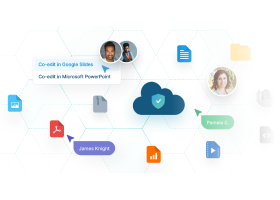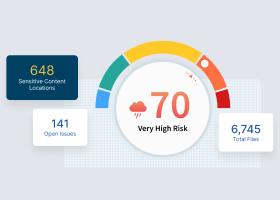What Is Data Sharing?
Data sharing is, for digital assets, the ability to share the same data resource with multiple applications or users. There are two core forms of data sharing—internal and external.
- Internal data sharing—between stakeholders in the same organization
- External data sharing—with third parties

The scope of data sharing, whether internal or external, is tremendous. It ranges between groups within a business to anonymized, publicly available databases used for research. However, the typical results are that data sharing allows people to learn from and collaborate with one another as well as amplify the reach and increase the potency of data.
Data sharing is the way to optimize higher-relevant data, generating more robust data and analytics to solve business challenges and meet enterprise goals.
Lydia Clougherty Jones, Senior Director Analyst, Gartner
FAIR for Good Data Sharing
There are four internationally accepted features of good data sharing. They are known as the FAIR data principles—findable, accessible, interoperable, and reusable.
The FAIR principles must be effectively implemented in order to support effective data sharing. Best practices for FAIR and data sharing are outlined below.
Findable
- Dataset is visible to search engines.
- Identifiers are explicitly included in the metadata.
- Metadata is grounded in standard, shared syntax.
- Data and metadata identifiers are unique and persistent.
Accessible
- Mechanisms for authentication and authorization are used to control access.
- Metadata is persistent.
- An open protocol is used for data and metadata retrieval.
Interoperable
- Strong data knowledge representation language is used.
- Metadata uses vocabulary that follows FAIR principles.
- Qualified outward references are contained in the metadata.
Reusable
- License for data sharing and usage is included in the metadata.
- Data source or origin is included in the metadata.
- Data is readable by machines and humans.
Data Sharing in the Cloud
Cloud data sharing, also called cloud-based file sharing or online file sharing, allows users to store data in the cloud and then give others access to it. This can be conducted on a one-to-one basis, or it can be set up to enable access across an organization.
In addition, data sharing can be done through websites that support open data sharing. This is commonly used for anonymized data or data that does not contain sensitive information.
When sensitive information is involved, data sharing in the cloud becomes more complex. There are challenges related to unauthorized data sharing or use, along with other security and compliance risks. These issues are addressed with security solutions that help manage data sharing as well as with security protocols enabled and supported by cloud service providers.
The three key players when considering secure data sharing in the cloud are:
- 1. Users
Responsible for implementing security options in the cloud application commiserate with the sensitivity of the data. - 2. SaaS providers
Responsible for the security of the data that is used with and generated by their applications. - 3. Cloud service providers
Responsible for the security of the cloud used for data sharing.
Secure Data Sharing
Secure data sharing is usually considered the responsibility of IT. However, secure data sharing is multi-faceted and encompasses technical, legal, procedural, and physical components.
Technical
- Access and sharing controls
- Data backup and recovery systems
- Encryption for data at rest and data in motion
- Private networks and virtual private networks (VPNs)
- Secure data storage for on-premise, cloud, and hybrid models
- Security assessments and audits
- Standards for anonymization and de-identification
- Strong authentication—passwords and multi-factor systems
Legal
- Agreements for data sharing (e.g., memorandums of understanding, data use licenses, cooperation agreements, release and waiver of intellectual property rights, non-disclosure agreements)
- Compliance requirements
- Organization and leadership liabilities
- Processes for data licensing
Physical
- Hardened systems for users and IT
- Perimeter and inside security, such as locked windows and doors, limited entry points with “gatekeepers,” and surveillance cameras
Procedural
- Audit trails (e.g., logs)
- Data oversight by data owners and data stewards
- Data quality review
- Documentation for data sharing and usage
- Incident response protocols
- Security and data usage training programs
- System for reviewing data access requests
These layers of security help prevent and mitigate the potential damage of a data breach or security incident. While it's not possible to guarantee that a data breach will not occur, these secure data sharing tactics ensure a strong line of defense against accidental or malicious data loss.
Data Sharing Policies
Before establishing data sharing policies, it is important to determine what the objectives are and if the potential risks outweigh the benefits. A few questions can help clarify whether data sharing is acceptable in a given situation:
- What is the vision, mission, and purpose of the data sharing arrangement?
- Do the data owners consent to the sharing approach, processes, and policies?
- Are there any laws or guidelines that prevent or constrain this data sharing?
- Is it ethical to share this data?
- Are the benefits of this data sharing more valuable than any risks?
Once the determination has been made that the data sharing arrangement should proceed, an agreement and related policies should be put into place.
A data sharing agreement is a formal contract that identifies the data being shared, how it may be used, and who can use it. The rules and processes for setting up data sharing agreements vary by country and jurisdiction as well as by the type of data being shared and the organizations that are sharing it.
Data sharing policies govern the use of the data as established in the agreement. Following are items typically included in data sharing policies and agreements.
Duration
- When the data will be made available
- How long the data will be available
- What happens when the data sharing period ends (e.g., data is returned, data is destroyed)
Use
- The purpose of the data sharing arrangement
- Additional uses beyond the stated purpose that are acceptable
- Restrictions on data use
- Documentation required for data use
- How data findings can be shared, published, or disseminated
- Who owns reports generated using the data—the receiver or provider
Confidentiality
- What, if any, parts of the data set are considered to be sensitive data
- Whether permissions are required to use sensitive data
- Limitations on sharing sensitive data
- Safeguards that are required to protect sensitive data
- What reporting is necessary if there is unauthorized access to sensitive data
Security
- User access controls
- Levels of data protection (e.g., passwords, encryption)
- Protocols to follow in the event of a data breach
Methods
- Cloud storage
- Encryption requirements for data in motion
Responsible Party for Related Expenses
- Storage
- Security
- Backup
Data Sharing Challenges
Individuals, businesses, and governments face many of the same data sharing challenges.
- Avoiding violations of intellectual property rights, copyrights, or other interests as a result of data sharing
- Covering the costs associated with data sharing (e.g., storage, data hygiene, data management)
- Deploying and managing data access control
- Implementing data security measures that provide protection at a level that meets the requirements of internal usage rules and compliance directives
- Loss of control over data sharing
- Organizing data so it can be used by others in a meaningful way
- Preventing data breaches and compromises related to data sharing, including:
- Accidental disclosure of sensitive information
- Deliberate disclosure of data by a malicious hacker
- Misuse of data for unauthorized purposes
- Re-identification of anonymized data
Data Sharing Benefits
For studies, data sharing benefits the researcher, research sponsors, data repositories, the scientific community, and the public. Data sharing saves time, enhances the quality of research results, and fosters better connections and collaboration between researchers.
For businesses, data sharing benefits the organization by providing increased visibility that improves decision-making. Previously siloed data can be aggregated to enable better results from analytics.
Other data sharing benefits for research and business:
- Allow researchers to share resources
- Benefit from the value of combined data that delivers results greater than the sum of separate individual datasets
- Build upon the work of others rather than repeat already existing research
- Contribute to open data to increase its value and power exponentially
- Drive higher quality data and analytics
- Enable new findings
- Encourage more connections and collaboration
- Improve transparency
- Incentivize better data management
- Increase data circulation and use
- Perform meta-analyses on a subject to gather broader trends over a wider regional or topic area
- Reduce monetary investment for science and research
Changes in Data Sharing
- Broader adoption of digital trust technologies, such as blockchain and smart contracts, to collect data more securely and efficiently
- Development of large-scale repositories that aggregate and share data from research projects conducted by experts in various fields of study
- Enhanced recognition of the needs of different research communities
- Greater acceptance of and willingness to engage in data sharing
- Increase in actual data sharing activities
- More efforts to build infrastructure that promotes data sharing
- Initiatives to replace the “don’t share data unless” mindset with “must share data unless”
Data Sharing and Business Outcomes
The correlation between data sharing and business outcomes is positive. When people and organizations share data, business outcomes improve.
Data sharing supports data-driven decision-making, which has many benefits, including improving operations and driving sales. Following are a few examples of how data sharing positively impacts business outcomes.
Better Customer Service
Data sharing across organizations can allow more people to use data to determine what customers like or want, or where they have issues. This can help direct marketing to position products in a way that appeals to customers.
Sales efforts can be focused on products that are top-of-mind for customers. Customer service can be alerted to recurring issues and offer solutions.
These findings can also be used to optimize systems. For example, findings from analysis, powered by data sharing, can identify more effective and efficient ways to respond to issues that come into customer support. This not only reduces time to resolution, but also improves the overall customer experience.
Opportunities to Gain a Competitive Advantage
Insights gained from data sharing can help organizations respond to market changes more quickly. With more data to work with, deeper and more advanced analytics can be used to predict trends, gain insights into customers’ behavior, and detect opportunities. Armed with this information, organizations are able to move faster and get closer to targets to gain a competitive advantage.
Increased Sales
Data sharing can increase sales by helping to identify market opportunities and increase share of wallet. Expanded access to data helps find new ways to sell and identifies areas that need improvement for both products and people.
For example, slower sales growth could be related to poor sales performance or issues on the product side, such as missing features, defects, or inventory problems. By reviewing data from across the organization, root causes can be uncovered so that the appropriate actions are taken to mitigate the issues. For instance, developing highly targeted sales and marketing strategies can solve the problem and result in improved sales performance and revenue growth.
New Business Opportunities
Rich datasets gained through data sharing can reveal insights that help businesses find additional revenue streams. These can come from product enhancements, new product development, and additional services that support users or add value to products.
For example, an online clothing store can add a product that customers are searching for, but is not in the existing catalog. It could also be discovered that customers buy a certain product in multiple colors, prompting the company to add a slightly different version of that piece to the catalog. Or, customers could be contacting the support team asking about how to get pants altered, creating an opportunity to partner with local tailors.
Data Sharing—Where 1+1=3
Data sharing can yield exponential returns on investments. Both for businesses and in the research community, data sharing enables more powerful analytics that yield better outcomes. However, ethical, relational, legal, and technical concerns must be addressed.
Successful data sharing requires establishing trust with data owners. This means providing assurances that data is being used securely and according to terms that all parties agree to abide by in the course of the data sharing arrangement.
Egnyte has experts ready to answer your questions. For more than a decade, Egnyte has helped more than 16,000 customers with millions of customers worldwide.
Last Updated: 4th February, 2022




